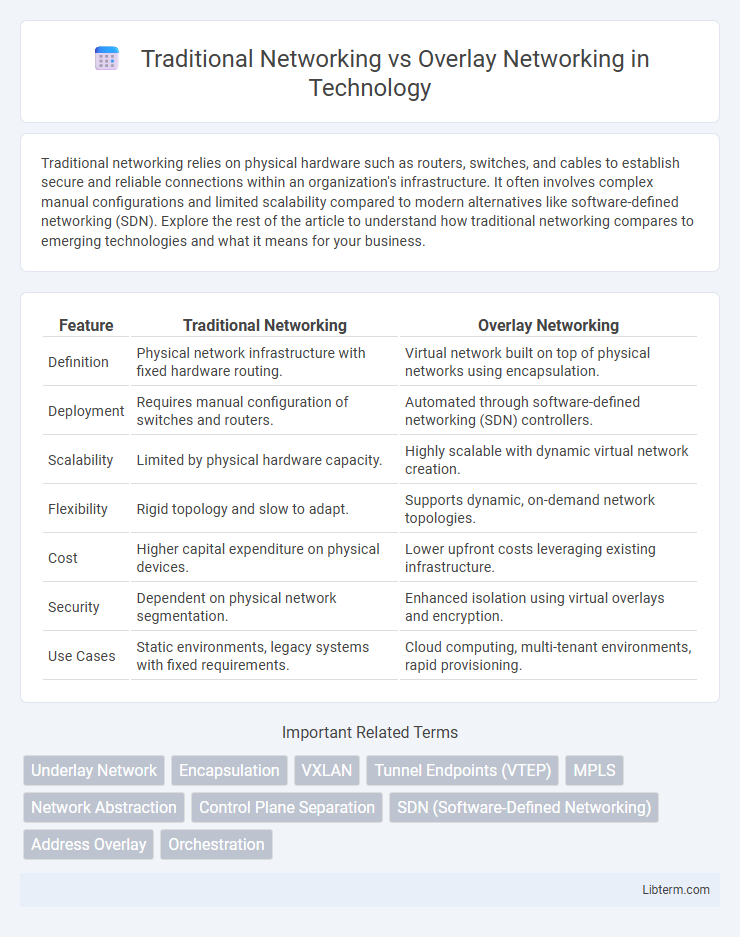Traditional networking relies on physical hardware such as routers, switches, and cables to establish secure and reliable connections within an organization's infrastructure. It often involves complex manual configurations and limited scalability compared to modern alternatives like software-defined networking (SDN). Explore the rest of the article to understand how traditional networking compares to emerging technologies and what it means for your business.
Table of Comparison
| Feature | Traditional Networking | Overlay Networking |
|---|---|---|
| Definition | Physical network infrastructure with fixed hardware routing. | Virtual network built on top of physical networks using encapsulation. |
| Deployment | Requires manual configuration of switches and routers. | Automated through software-defined networking (SDN) controllers. |
| Scalability | Limited by physical hardware capacity. | Highly scalable with dynamic virtual network creation. |
| Flexibility | Rigid topology and slow to adapt. | Supports dynamic, on-demand network topologies. |
| Cost | Higher capital expenditure on physical devices. | Lower upfront costs leveraging existing infrastructure. |
| Security | Dependent on physical network segmentation. | Enhanced isolation using virtual overlays and encryption. |
| Use Cases | Static environments, legacy systems with fixed requirements. | Cloud computing, multi-tenant environments, rapid provisioning. |
Introduction to Networking Paradigms
Traditional networking relies on physical devices such as routers, switches, and cables to establish direct communication paths within a network infrastructure. Overlay networking builds virtual networks atop the existing physical infrastructure, using encapsulation protocols like VXLAN or GRE to create isolated and flexible network segments. This paradigm shift enables scalable, software-defined network management and enhances connectivity in cloud and data center environments.
What is Traditional Networking?
Traditional networking refers to the physical infrastructure of interconnected devices using hardware components like routers, switches, and cables to manage data flow within local or wide area networks. It relies on fixed IP addressing, VLANs, and manual configuration to control traffic and ensure communication between devices in a structured topology. This approach emphasizes hardware-centric management and lacks the flexibility and scalability found in overlay networking solutions.
Defining Overlay Networking
Overlay networking creates virtual networks on top of existing physical networks, enabling more flexible and scalable connectivity options compared to traditional networking. It abstracts the underlying infrastructure by using encapsulation protocols like VXLAN or GRE to facilitate isolated communication across distributed environments. This approach supports dynamic network provisioning, simplified management, and enhanced segmentation in cloud and software-defined network (SDN) deployments.
Key Architectural Differences
Traditional networking relies on physical infrastructure such as routers, switches, and cabling to establish direct paths for data transmission within a fixed topology. Overlay networking, by contrast, builds virtual networks on top of existing physical networks using encapsulation protocols like VXLAN or GRE to create flexible, isolated communication channels independent of underlying hardware. Key architectural differences include the fixed, hardware-dependent routing of traditional networks versus the software-defined, scalable, and dynamic routing capabilities of overlay networks.
Control and Management Planes
Traditional networking relies on tightly integrated control and management planes within physical devices, where routing decisions and network policies are handled locally on routers and switches. Overlay networking separates these planes by decoupling the control plane from the data plane, using centralized controllers to manage virtual networks that run atop physical infrastructure. This abstraction enables greater scalability, flexible policy enforcement, and simplified network orchestration compared to the rigid device-centric model of traditional networking.
Scalability and Flexibility Comparison
Traditional networking relies on physical infrastructure, which limits scalability due to hardware constraints and complex configurations. Overlay networking uses virtual layers built on top of existing networks, enabling greater scalability by abstracting resources and simplifying management. The flexibility of overlay networks supports dynamic provisioning and seamless integration with cloud environments, outperforming traditional setups in adapting to changing workloads.
Security Implications
Traditional networking relies on physical hardware and predefined IP routing, exposing networks to risks such as unauthorized access and data interception due to limited encryption and static configurations. Overlay networking creates virtualized network layers over existing infrastructure, enhancing security through encapsulation, dynamic segmentation, and end-to-end encryption protocols like VXLAN or GRE tunnels. The flexibility of overlay networking allows for micro-segmentation and improved threat isolation, reducing the attack surface compared to traditional flat network topologies.
Performance and Latency Considerations
Traditional networking relies on fixed physical infrastructure, resulting in lower latency and higher performance due to direct packet forwarding and dedicated hardware acceleration. Overlay networking introduces encapsulation layers and virtualized tunnels, which can increase latency and computational overhead, potentially impacting throughput and real-time application performance. Optimizing overlay networks with technologies like VXLAN and SR-IOV mitigates latency but often cannot match the raw performance efficiencies of traditional networking in high-throughput, low-latency environments.
Use Case Scenarios
Traditional networking suits environments requiring direct control over physical infrastructure, such as enterprise data centers or service provider backbones, where predictable performance and strict security policies are critical. Overlay networking excels in cloud-native applications, multi-tenant environments, and software-defined data centers by abstracting physical topology to enable rapid scalability, seamless workload mobility, and dynamic segmentation. Use cases like hybrid cloud integration, microservices architectures, and virtualized network functions benefit from overlay networks for agility and simplified management.
Future Trends in Networking Architecture
Future trends in networking architecture emphasize the shift from traditional networking, which relies on fixed physical infrastructure and manual configurations, to overlay networking that leverages virtualized networks over physical hardware, enabling greater flexibility and scalability. Innovations such as Software-Defined Networking (SDN) and Network Function Virtualization (NFV) drive the adoption of overlay networks by decoupling the control plane from the data plane, supporting dynamic resource allocation and enhanced automation. As 5G, edge computing, and IoT proliferate, overlay networking architectures promise to deliver improved network agility, security, and efficient management tailored to complex, distributed environments.
Traditional Networking Infographic

 libterm.com
libterm.com